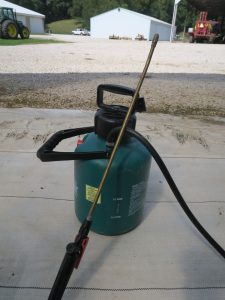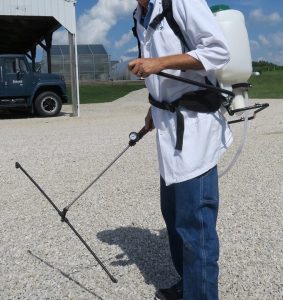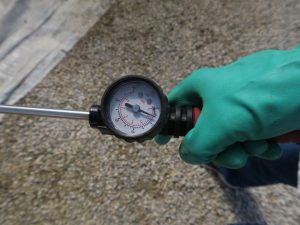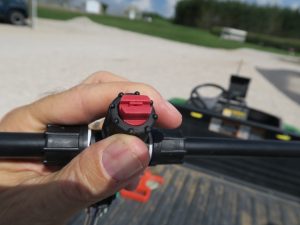The use of tractor drawn pesticide sprayers is not practical for many smaller growers. Two alternatives are garden-sprayers or backpack sprayers. I will argue here that garden-sprayers are not suited for most commercial pesticide use.
The typical garden sprayer that may be found at a garden shop or hardware store usually has a 1 or 2-gallon capacity and a nozzle whose output may be manually adjusted from stream to spray (Figure 1). Such sprayers use air pressure generated by a hand pump. Some models have a valve to quick-release air pressure. While such sprayers may be useful for cleaning tasks, they are not appropriate for commercial pesticide applications for the reasons stated below.

Figure 1. A typical garden sprayer with an adjustable nozzle and hand pump is not suitable for applying most commercial pesticides.
Let’s start off discussing the adjustable nozzles on garden sprayers. These nozzles may be inadvertently moved to provide a different stream or spray. That is, the output may be changed from a full spray to a more stream-like output. We quantified the output of a garden sprayer in a stream vs spray mode. The output in stream mode was more than twice the output in spray mode. This means that if one accidentally turns a spray nozzle, the volume output will change.
It is important for the output on a sprayer to remain constant because most commercial pesticide labels are based on amount per area—for example, fl. oz. per acre. If the output changes, the amount of pesticide applied changes. If the amount of pesticide is less than the labeled amount, the application will likely be ineffective. Too much pesticide wastes money and may cause damage to the plant. Therefore, the adjustable nozzles that are so useful for household jobs make garden sprayers unsuited for commercial pesticide applications.
A second disadvantage for the use of garden sprayers for commercial pesticide application is the difficulty in maintaining a constant pressure. The method of creating pressure in a garden sprayer is by a hand pump. This pressure, however, will begin to decrease with use. As pressure decreases, output also decreases. Therefore, to maintain constant pressure and output the hand-pump needs to be in constant use. For most users, constant use of the hand-pump of garden sprayer is impractical.
To demonstrate how output of the garden sprayer changes with pressure, we collected volume of a sprayer with 5 hand pumps vs 15 pumps. The output with 15 pumps was almost twice the output with 5 pumps. As discussed above, most commercial pesticide labels are on an area basis. Therefore, a sprayer with an output that varies with pressure/time is unacceptable.
Most backpack sprayers, in contrast, are well suited for commercial pesticide use (Figure 2). Effective backpack sprayers will have:
- Fixed hollow cone or flat fan nozzles located on a boom. Sprayers with 3-4 nozzles located on a boom are easier to use and calibrate than wand type sprayers such as in Figure 1.
- An easy to read pressure gauge so that the same output can be maintained throughout the field (Figure 3). The sprayer may be powered by a motor, CO2 or by a hand-pump.
- For most applications, a 4-5-gallon capacity should be adequate.

Figure 2. This backpack sprayer has three nozzles on a boom and a hand-pump that can be worked constantly.
Fixed or hollow-cone nozzles are designed for pesticide application (Figure 4). Such nozzles are fixed and provide a constant output. The sprayer shown here was modified from a single wand to a boom with three nozzles. The total for back pack sprayer and boom was about $100. The use of nozzles on a boom allow for easy calibration and use. The backpack sprayer in figure 2 allows the user to hold the boom in one hand and constantly pump with the other so that proper pressure is maintained. Note that a gauge on the handle allows one to monitor the pressure periodically.
A separate article will discuss the use and calibration of a backpack sprayer.

